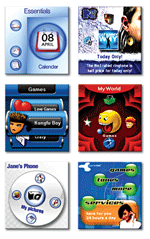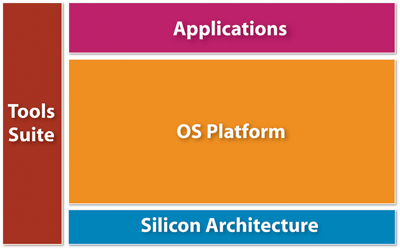Platforms enable faster and more efficient product innovation
BY TODD BRIAN
Mentor Graphics
Mobile, AL
http://www.mentor.com/embedded
It’s no surprise that the consumer electronics market, and especially the handset market, is more competitive today than ever before. Even established leaders are fighting furiously to maintain their position. The fight for dominance is understandable; consumer electronics is one industry where coming in second can sometimes mean the same as coming in last.
Silicon and software vendors are also racing to keep their competitiveness in a market that not even a futurist would have predicted just 10 years ago. This is a market where one must be nimble and quick. In no other industry can a new product be proposed, developed, deployed, gain dominance, and then be replaced within a 12-month period.
Business needs drive smart features
High-end smart phones and PDAs are typically business oriented and always feature rich (with some notable exceptions like the iPhone). Since these devices are business phones first, emphasis is placed on the ability to seamlessly manage documents such as e-mail, files, and video as well as accessing and exchanging data over wireless and/or cellular networks. WinCE, Symbian, and Palm all offer operating systems that power these high-end devices.
Both high- and low-end devices are susceptible to a very short lifecycle. Unlike the $499 high-end model, the low-end device, while not exactly a business phone, still provides the “must-have” basics such as telephony, messaging, and multimedia (music, video, photos) functions. All of these different, yet interrelated, technologies must be combined to offer a single homogeneous user experience. Oh, and it has to be lightweight, intuitively easy to use, low powered, and have low BOM cost.
Regardless of the type of device, doing all of the above within a 12-month cycle is a grueling experience. Even basic capabilities on most personal devices require the ability to store, retrieve, play, copy, browse, and otherwise manage content across a diverse set of media. An even at the lowest level, support for multimedia might use a hardware codec to accelerate decoding and rendering of encoded media.
All of this revolves around basic system capabilities such as connectivity, file storage, and graphics along with all the drivers for the peripheral hardware. Companies like Samsung, Nokia, and LG have hundreds, if not thousands of engineers maintaining and enhancing their phone software.
In spite of the smart-phone craze, there is still more demand for the $49 phone over the $499 phone. The challenge for device manufacturers is how to meet demand for more content, connectivity, and ease of use – and do it in the most profitable way possible. One approach developers can use to keep costs down is to employ XML-based technology to create multimedia user interfaces (UIs), eliminating the need to alter the software stack (see Fig. 1 ).

Fig. 1. Examples of rRich multimedia UIs for mobile handsets can be, created by an XML-based engine.
Feature phones have unique needs.
The manufacturer of the $49 phone is far more constrained in how it approaches the problem. The two conflicting goals are satisfactory performance and low cost. By bringing together the right mix of OS software or “application-ware,” hardware designers can meet these demands.
The perfect example is in the area of multimedia. The requirements of the mainstream consumer markets could be broadly defined as 30-fps video or better, and the decoding of MPEG-4 or H.264 formats, which are very computationally intensive. Using a hardware codec, 30 fps is easily achieved with a 40-MHz ARM7 application processor. Silicon providers are further facilitating this by offering a hardware codec that complies with accepted standards like OpenMAX — a hardware API that increases the portability of software across a wide range of hardware.
Another way to make the $49 device more achievable is to exclude business functionality. This not only reduces the features that have to be developed, but also much of the overhead provided by a business-centric cell phone OS. For example, a huge number of WinCE APIs are provided exclusively for document management and interoperability between the device and the desktop. That overhead does not exist on the $49 device.
Reducing the software footprint places a lesser burden on the hardware both from the performance and footprint perspective and reduces power consumption and BOM costs.
From a designer’s perspective, particularly from the human factor or usability stand point, the smart-phone OS is a wonderful place to start. Typically, the most popular phone architectures such as Texas Instrument’s OMAP3 family of processors are supported. The smart-phone OS has an extensive API that caters directly to this type of development and also has a development environment that promotes multivendor applications. However, one of the largest potential contributors to increased BOM costs are large run-time royalties.
A second approach
Most feature phone vendors try to do most of this design work internally, in conjunction with hardware/software partners. Another way to package the OS and software might include:
Providing services above the traditional RTOS and OS offeringEnhancing portability and reuse of application level softwareEnabling interoperability of application softwareAllowing extension of OS, hardware, and driversProviding an open development environmentEnabling ARM11 (700-MHz) performance on ARM7 (40-MHz) hardware
While somewhat ambitious, these goals are driving the ongoing evolution of next-generation products from a number of vendors, including Mentor Graphics Nucleus OS for portable consumer electronic devices (see Fig. 2 ).

Fig. 2. A device-manufacturing platform for device manufactures that bridges the difference between traditional RTOS capabilities and application-oriented operating systems.
Future platforms
With this approach, future platforms will be based on a full-featured operating system containing the latest in networking and connectivity, file, storage, and USB capabilities. It will include the latest technology in graphics/multimedia and support industry APIs such as OpenMAX. For devices that are not OpenMAX compliant, the multimedia framework can still exploit codec support and provide a common interface to the application layer. XML driven menus, graphical and multimedia capabilities are offered complete with hardware integration. Further, a cost-effective development environment meets the needs of the in-house engineering team as well as independent third-party software providers. The supporting tool suite, containing an IDE, compiler, debugger, profiler and simulation environment, can be extended and packaged as a device specific software development kit (SDK) by chipset vendors and handset manufacturers.
The next-generation OS has to be optimized for various embedded applications. Much like the difference between an off-the-rack suit vs. a fitted suit, every line of code on the device is there explicitly due to the design of the device and can be easily extended and customized so that the OS environment is an exact fit. This provides peak silicon performance.
This new type of full-featured OS platform also goes beyond the current embedded RTOS systems by offering kernel and middleware. At the top of the software stack, the focus is on delivering application-level software that removes the burden of producing, integrating, and maintaining user interface, graphical, and multimedia software. At the bottom and throughout the software stack, the focus is on providing a portable interface with high performance and power conserving hardware such as codec, accelerators, and peripheral controllers. ■
For more on operating systems, visit http://electronicproducts-com-develop.go-vip.net/software.asp.
Advertisement
Learn more about Mentor Graphics





